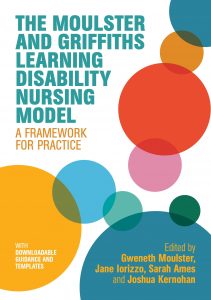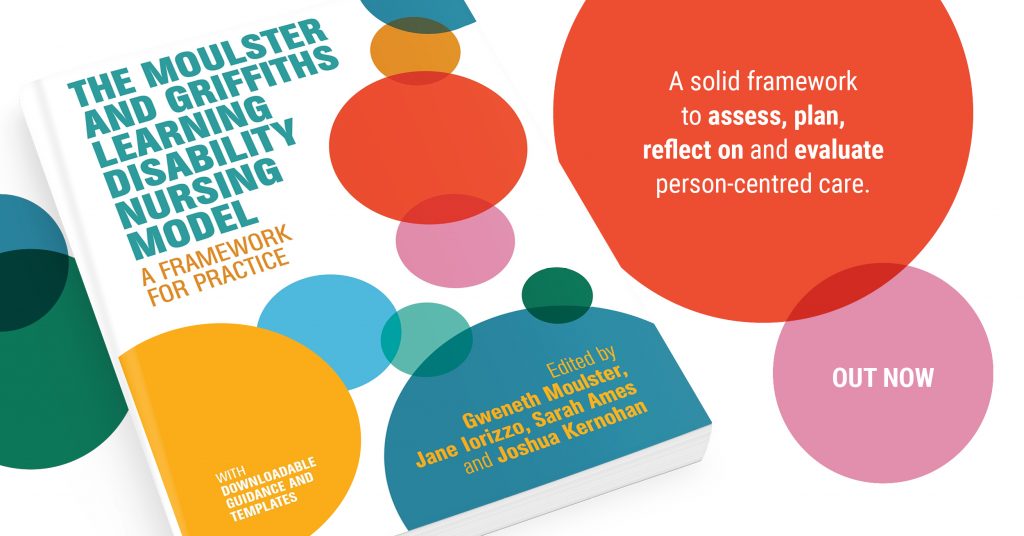The Moulster and Griffiths Learning Disability Nursing Model: A Framework for Practice was co-written and edited by Gwen Moulster, Jane Iorizzo, Sarah Ames and Joshua Kernohan. Below is a blog about the book by author Jane Iorizzo.
Between the editors, there is over 60 years of nursing experience in the field of learning disability, both in the UK and overseas. The Moulster and Griffiths Model for Learning Disability Practice was initially written by Gwen and her colleague Tom Griffiths who felt there was no existing model that met the needs of learning disability nurses. Since then, it has grown significantly, after ongoing development by the book editors, and has been implemented in learning disability nursing settings across the world. In writing the book, Gwen, Jane, Sarah and Joshua hoped to share good practice, support other nurses, and provide a model that enables learning disability nurses to evidence the incredible work that they do daily, as well as the need for it, and the profession, to continue.
Others who have personal and professional experience in meeting the needs of people who have learning disabilities were invited to contribute chapters to the book, which brings a mix of experiences and backgrounds to the writing. Along with this, the reader will also find downloadable content, examples of the model’s tools in practice, family stories, top tips, suggestions for further reading, and case studies, such as that of Sofia…
Sofia, a 41-year-old woman who has a mild learning disability and Down’s Syndrome, and her learning disability nurse, Louise, take the reader through the process of completing a person-centred screen. Sofia is an engaging individual, with a love for all things dance, a wonderfully close relationship with her family, and a fiercely protective nature. She had been referred to community learning disability nursing services by her GP, after her sister had raised concerns about changes in Sofia’s personality, mood and communication.
Strain was being placed on the sisters’ relationship like never before, as Sofia refused to even sleep in her room for fear of disturbing her impressive collection of dance magazines, clothes, shoes, photos and more. She became anxious about leaving the house for fear that they may be stolen, and frequently became very angry at her sister for questioning her choices around this. Sofia had become confused on many occasions, and her communication skills were changing; she was becoming more reliant on visual aids than ever before.
Although Sofia’s GP had referred her for assessment, this had taken some persuasion from the family, and neither Sofia nor her sister were happy with the GP services they had received. Hearing all of these issues, Louise would probably have made assumptions about what Sofia would like to change, what she may be struggling with, and what Louise could do about it. However, the purpose of the person-centred screen is to take an initial step back and get a better understanding of the person, their dreams and their wishes. This means that any health outcomes later suggested by the nurse are in line with the person’s own belief systems and life goals.
Louise spent time at Sofia’s home, and begun to understand these difficulties better from Sofia’s point of view. Her dreams of her bedroom remaining ‘off limits’, having sleepovers with her cousins, and seeing the doctor less could now be used in setting health outcomes that were meaningful for Sofia. If people would go in her room regardless, than why would Sofia want to visit her GP again? If however, visiting the GP meant Sofia felt well enough to visit her cousins she would likely feel more motivated to improve her health. Not only was completing the person-centred screen hugely supportive of Louise’s care planning and implementation, but it also provided valuable information as part of her holistic health assessment. Much of the information obtained would have been missed in a standard nursing assessment.
For people who have learning disabilities, all too often things are decided on their behalf in what others perceive to be in their best interests. But if a nurse doesn’t carry out a comprehensive, holistic and person-centred assessment, then how can they be sure that their work won’t be doing just this? How often as health professionals do we take a step back and consider what beliefs, dreams or goals an individual has and how that impacts on what they want for their health? The Moulster and Griffiths Learning Disability Nursing Model: A Framework for Practice supports the reader to consider this and complete a tool that they can revisit throughout their work to ensure that the person’s desires and belief systems stay central. It is their life after all.
You might like to read Jane’s other blog: The Best and Worst of Learning Disability Care
 The Moulster and Griffiths Learning Disability Nursing Model
The Moulster and Griffiths Learning Disability Nursing Model
A Framework for Practice
Edited by Gweneth Moulster, Jane Iorizzo, Sarah Ames and Joshua Kernohan
Describing the Moulster and Griffiths nursing model, this book demonstrates how learning disability nurses can use it in practice. It provides an effective framework to assess, plan, reflect on and evaluate person-centred care, considering the complex needs of people who have learning disabilities, their families and their carers.
If you would like to read more articles like this and get the latest news and offers on our health care books, why not join our mailing list? We can send information by email or post as you prefer. You may also be interested in liking our Social Work, Mental Health and Health Care Facebook page.
